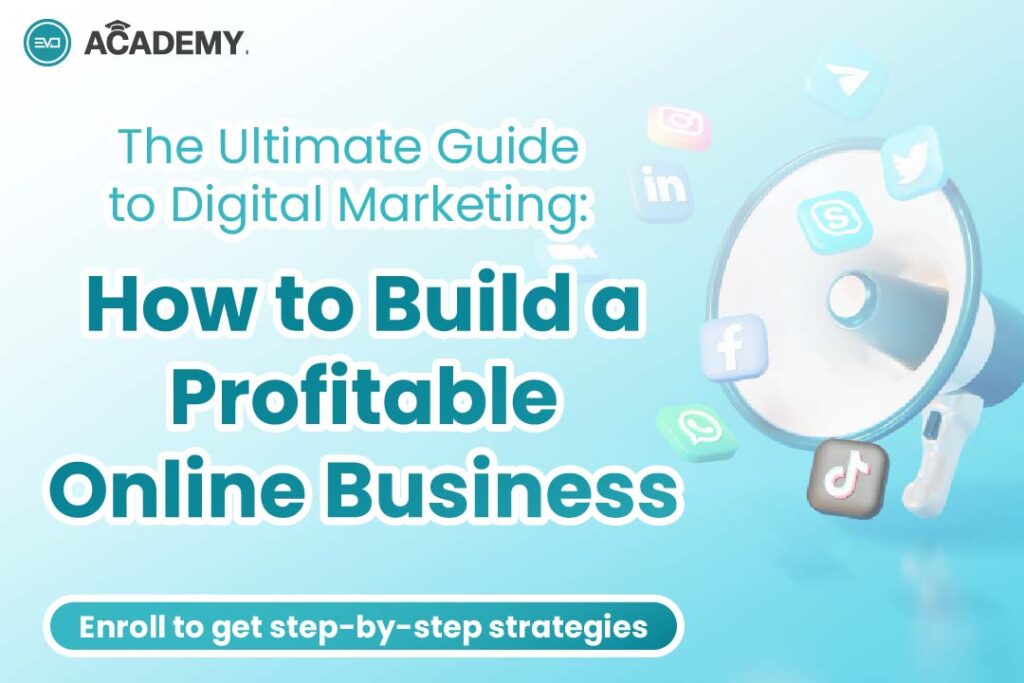If you’re trying to grow a business online, mastering digital marketing is no longer optional—it’s essential. Whether you’re an entrepreneur, freelancer, coach, or small business owner, this digital marketing guide will walk you through the proven strategies to fuel online business growth, attract quality leads, and convert them into paying customers.
With the right approach, you don’t need a huge team or big budget to build a profitable online business. You just need a clear framework—and that’s what you’ll get here.
1. What is Digital Marketing?
Digital marketing is the use of online platforms and digital tools to promote products, services, and brands. Unlike traditional marketing (TV, radio, print), digital marketing is trackable, scalable, and data-driven.
Core Channels of Digital Marketing:
- Search Engine Optimization (SEO)
- Content Marketing
- Email Marketing
- Social Media Marketing
- Pay-Per-Click Advertising (PPC)
- Affiliate Marketing
- Video Marketing
💡 Whether you’re selling physical products, services, or info products, digital marketing allows you to attract your ideal customer at scale.
2. Step 1: Build a Strong Online Foundation
Create a Conversion-Ready Website
Your website is your 24/7 sales machine. It should load fast, look professional, and be optimized for both desktop and mobile.
Must-haves:
- Clear headline (what you do & who you help)
- Lead magnet or CTA above the fold
- Trust elements (testimonials, case studies)
- Fast loading speed and mobile responsiveness
- SEO-optimized content
Build a Strong Brand Identity
What makes you different from competitors? Define your:
- Brand message
- Unique selling proposition (USP)
- Voice and tone
Brand consistency builds trust, which is essential for online conversions.
3. Step 2: Drive Traffic with SEO & Content Marketing
Search Engine Optimization (SEO)
SEO helps your website rank on Google, so you get free traffic consistently.
Key SEO tasks:
- Perform keyword research (use tools like Ubersuggest or Ahrefs)
- Optimize meta titles, descriptions, headers
- Create high-value blog content (like this one!)
- Build backlinks from other reputable websites
💡 Need help with SEO? Get my proven SEO framework when you enroll in the course.
Content Marketing
Educate before you sell. Blog posts, YouTube videos, case studies, and infographics are powerful tools to:
- Build trust
- Generate traffic
- Nurture leads
Use content to guide people along the buyer journey.
4. Step 3: Use Social Media to Attract & Nurture Leads
Pick the Right Platform
Not every platform is right for every business. Choose based on where your audience hangs out:
- Instagram: Visual brands, coaches, eCommerce
- Facebook: Communities, local services
- TikTok: Gen Z, viral growth
- LinkedIn: B2B, professionals
Develop a Social Media Strategy
A good social media strategy focuses on:
- Consistent posting
- Value-based content (educational, inspirational, behind-the-scenes)
- Strategic calls-to-action
- Building community, not just followers
💡 Social media builds warm audiences—the people most likely to buy from you later.
5. Step 4: Turn Followers into Customers with Email Marketing
Building an email list is one of the best assets for online business growth.
How to Build Your List:
- Offer a freebie (lead magnet) in exchange for emails
- Add opt-in forms across your website
- Promote the freebie via social media
What to Send:
- Welcome sequence
- Weekly value emails (tips, updates)
- Exclusive offers
- Case studies or success stories
💡 Email marketing is the most cost-effective way to convert leads into customers.
6. Step 5: Accelerate Growth with Paid Ads
Facebook & Instagram Ads
These platforms are ideal for:
- Retargeting warm audiences
- Running low-budget experiments
- Driving traffic to lead magnets or offers
Google Ads
Perfect for high-intent keywords like:
- “Buy running shoes online”
- “SEO consultant near me”
Focus on:
- Clear messaging
- Strong offer
- Landing page alignment
💡 Want to run ads with confidence? Learn step-by-step ad strategies in my course.
7. Step 6: Use Funnels to Automate Sales
A sales funnel guides your leads from “just curious” to “ready to buy.”
Example funnel:
- Social media post → Free lead magnet
- Email sequence → Value and education
- Product/service pitch → Call to action
Funnels = consistent income without constantly selling manually.
8. Step 7: Track, Analyze & Optimize
You can’t improve what you don’t measure.
Key Metrics to Monitor:
- Website traffic (Google Analytics)
- Lead conversion rate
- Email open and click-through rates
- Ad ROAS (return on ad spend)
- Social media engagement
Use tools like:
- Google Analytics
- Facebook Ads Manager
- Hotjar (for behavior tracking)
Adjust based on what’s working and cut what’s not.
Conclusion
Starting or growing an online business is exciting—but without a clear marketing roadmap, it’s easy to get lost. This digital marketing guide gives you the exact structure to build a sustainable, profitable business using strategies that actually work.
You don’t need to figure this all out alone.
Ready to grow your online business with confidence?
Enroll in my course and get step-by-step strategies, templates, and expert support.
Let’s turn your online business into a success story.




